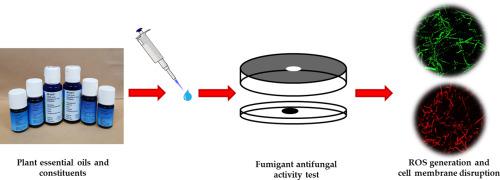当前位置:
X-MOL 学术
›
Pestic. Biochem. Phys.
›
论文详情
Our official English website, www.x-mol.net, welcomes your
feedback! (Note: you will need to create a separate account there.)
Reactive oxygen species mediated-antifungal activity of cinnamon bark (Cinnamomum verum) and lemongrass (Cymbopogon citratus) essential oils and their constituents against two phytopathogenic fungi
Pesticide Biochemistry and Physiology ( IF 4.2 ) Pub Date : 2020-09-01 , DOI: 10.1016/j.pestbp.2020.104644 Ji-Eun Lee 1 , Seon-Mi Seo 2 , Min-Jung Huh 3 , Sung-Chan Lee 3 , Il-Kwon Park 2
Pesticide Biochemistry and Physiology ( IF 4.2 ) Pub Date : 2020-09-01 , DOI: 10.1016/j.pestbp.2020.104644 Ji-Eun Lee 1 , Seon-Mi Seo 2 , Min-Jung Huh 3 , Sung-Chan Lee 3 , Il-Kwon Park 2
Affiliation

|
To find new and safe type of control agents against phytopathogenic fungi, the fumigant antifungal activity of 10 plant essential oils and constituents identified in cinnamon bark (Cinnamomum verum) and lemongrass (Cymbopogon citratus) essential oils was investigated against two phytopathogenic fungi, Raffaelea quercus-mongolicae and Rhizoctonia solani. Among plant essential oils, cinnamon bark and lemongrass essential oils showed 100% inhibition of R. quercus-mongolicae and R. solani at 5 mg/paper disc, respectively. Among test constituents, salicylaldehyde, eugenol, and hydrocinnamaldehyde showed 100% inhibition of growth of R. quercus-mongolicae at 2.5 mg/paper disc. Neral, geraniol, geranial, trans-cinnamaldehyde, methyl cinnamate, isoeugenol, and methyl eugenol exhibited >80% inhibition of growth of R. quercus-mongolicae at 2.5 mg/paper disc. Neral, geranial, trans-cinnamaldehyde, hydrocinnamaldehyde, and salicylaldehyde showed 100% inhibition of growth of R. solani at 2.5 mg/paper disc. A fumigant antifungal bioassay of artificial blends of the constituents identified in cinnamon bark and lemongrass essential oils indicated that trans-cinnamaldehyde and geranial were major contributors to the fumigant antifungal activity of the artificial blend. Confocal laser scanning microscopy images of fungi treated with cinnamon bark and lemongrass essential oils, trans-cinnamaldehyde, neral, and geranial revealed the reactive oxygen species (ROS) generation and cell membrane disruption.
中文翻译:

肉桂皮(Cinnamomum verum)和柠檬草(Cymbopogon citratus)精油及其成分对两种植物病原真菌的活性氧介导的抗真菌活性
为了寻找新型安全的植物病原真菌防治剂,研究了肉桂皮 (Cinnamomum verum) 和柠檬草 (Cymbopogon citratus) 精油中 10 种植物精油和成分对两种植物病原真菌 Raffaelea quercus 的熏蒸抗真菌活性。 mongolicae 和 Rhizoctonia solani。在植物精油中,肉桂皮和柠檬草精油在 5 毫克/纸盘时分别显示 100% 抑制 R. quercus-mongolicae 和 R. solani。在测试成分中,水杨醛、丁子香酚和氢化肉桂醛在 2.5 毫克/纸盘下显示 100% 抑制 R. quercus-mongolicae 的生长。Neral、香叶醇、香叶醛、反式肉桂醛、肉桂酸甲酯、异丁香酚和甲基丁香酚在 2 时对 R. quercus-mongolicae 的生长具有 >80% 的抑制作用。5 毫克/纸盘。天然、香叶、反式肉桂醛、氢化肉桂醛和水杨醛在 2.5 毫克/纸盘下显示 100% 抑制茄属植物的生长。对肉桂皮和柠檬草精油中确定的成分的人工混合物进行熏蒸抗真菌生物测定表明,反式肉桂醛和香叶是人工混合物熏蒸抗真菌活性的主要贡献者。用肉桂皮和柠檬草精油、反式肉桂醛、橙花和天竺葵处理的真菌的共聚焦激光扫描显微镜图像揭示了活性氧 (ROS) 的产生和细胞膜的破坏。对肉桂皮和柠檬草精油中确定的成分的人工混合物进行熏蒸抗真菌生物测定表明,反式肉桂醛和香叶是人工混合物熏蒸抗真菌活性的主要贡献者。用肉桂皮和柠檬草精油、反式肉桂醛、橙花和天竺葵处理的真菌的共聚焦激光扫描显微镜图像揭示了活性氧 (ROS) 的产生和细胞膜的破坏。对肉桂皮和柠檬草精油中确定的成分的人工混合物进行熏蒸抗真菌生物测定表明,反式肉桂醛和香叶是人工混合物熏蒸抗真菌活性的主要贡献者。用肉桂皮和柠檬草精油、反式肉桂醛、橙花和天竺葵处理的真菌的共聚焦激光扫描显微镜图像揭示了活性氧 (ROS) 的产生和细胞膜的破坏。
更新日期:2020-09-01
中文翻译:

肉桂皮(Cinnamomum verum)和柠檬草(Cymbopogon citratus)精油及其成分对两种植物病原真菌的活性氧介导的抗真菌活性
为了寻找新型安全的植物病原真菌防治剂,研究了肉桂皮 (Cinnamomum verum) 和柠檬草 (Cymbopogon citratus) 精油中 10 种植物精油和成分对两种植物病原真菌 Raffaelea quercus 的熏蒸抗真菌活性。 mongolicae 和 Rhizoctonia solani。在植物精油中,肉桂皮和柠檬草精油在 5 毫克/纸盘时分别显示 100% 抑制 R. quercus-mongolicae 和 R. solani。在测试成分中,水杨醛、丁子香酚和氢化肉桂醛在 2.5 毫克/纸盘下显示 100% 抑制 R. quercus-mongolicae 的生长。Neral、香叶醇、香叶醛、反式肉桂醛、肉桂酸甲酯、异丁香酚和甲基丁香酚在 2 时对 R. quercus-mongolicae 的生长具有 >80% 的抑制作用。5 毫克/纸盘。天然、香叶、反式肉桂醛、氢化肉桂醛和水杨醛在 2.5 毫克/纸盘下显示 100% 抑制茄属植物的生长。对肉桂皮和柠檬草精油中确定的成分的人工混合物进行熏蒸抗真菌生物测定表明,反式肉桂醛和香叶是人工混合物熏蒸抗真菌活性的主要贡献者。用肉桂皮和柠檬草精油、反式肉桂醛、橙花和天竺葵处理的真菌的共聚焦激光扫描显微镜图像揭示了活性氧 (ROS) 的产生和细胞膜的破坏。对肉桂皮和柠檬草精油中确定的成分的人工混合物进行熏蒸抗真菌生物测定表明,反式肉桂醛和香叶是人工混合物熏蒸抗真菌活性的主要贡献者。用肉桂皮和柠檬草精油、反式肉桂醛、橙花和天竺葵处理的真菌的共聚焦激光扫描显微镜图像揭示了活性氧 (ROS) 的产生和细胞膜的破坏。对肉桂皮和柠檬草精油中确定的成分的人工混合物进行熏蒸抗真菌生物测定表明,反式肉桂醛和香叶是人工混合物熏蒸抗真菌活性的主要贡献者。用肉桂皮和柠檬草精油、反式肉桂醛、橙花和天竺葵处理的真菌的共聚焦激光扫描显微镜图像揭示了活性氧 (ROS) 的产生和细胞膜的破坏。











































 京公网安备 11010802027423号
京公网安备 11010802027423号